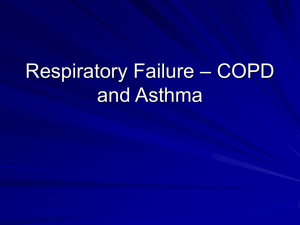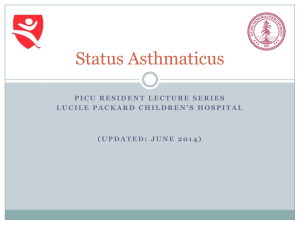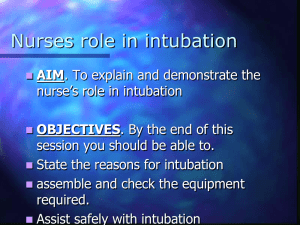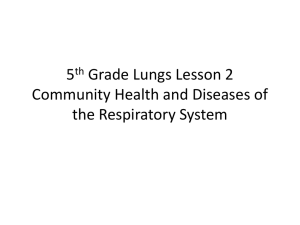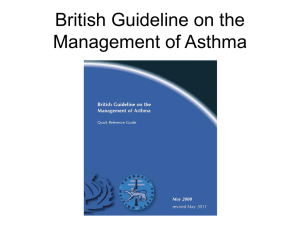Acute Respiratory Failure and Asthma
advertisement
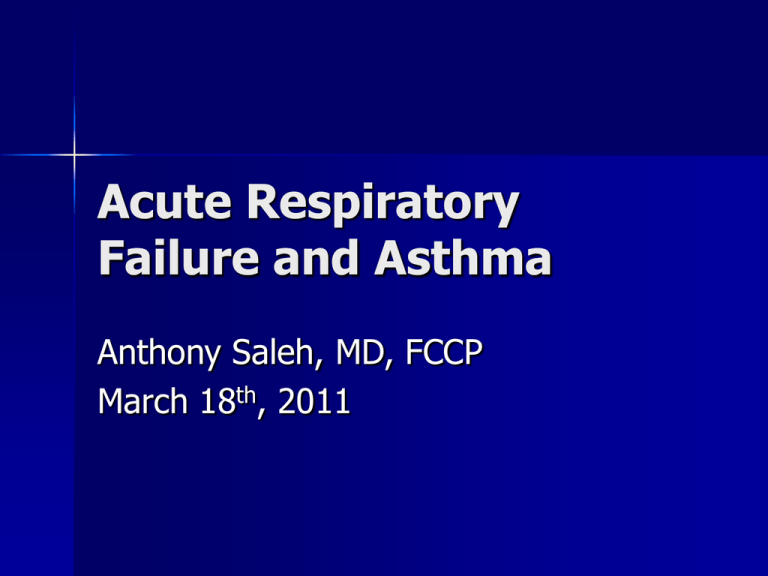
Acute Respiratory Failure and Asthma Anthony Saleh, MD, FCCP March 18th, 2011 Disclosures No financial disclosures Avid New York Yankee fan Michael Jordan admirer Favorite movie: “Godfather 1” Major supporter of respiratory therapists Outline Scope of the problem Pathophysiology Management Invasive/ Non invasive Specific Ventilatory Strategies Asthma: Definition A chronic inflammatory disorder of the airways in which many cells and cellular elements play a role Susceptible patients develop recurrent episodes of wheezing, chest tightness, and coughing, especially at night or in the early morning These episodes are associated with widespread but variable airflow obstruction, that is often reversible Prevalence Increasing worldwide over the past few decades In the United States approximately 16.1 million adults and 6.8 million children have a diagnosis of asthma Overall prevalence about 8 % Fatalities slowly declining, but still excessive Multiple etiologies for poor outcome Asthma Fatalities (cont) Peaked in 2003 Higher death rates in: Older patients (greater than 65), females, Puerto Ricans, non Hispanic blacks Some proposed mechanisms: Inner city lower socioeconomic class Lack of education Health care disparities Pathophysiology A complex inflammatory disease of the airways Inflammation is the hallmark with ensuing complicated cascades A variety of pathways are intertwined Treatment focuses on multiple different sites of inflammatory activity Management Acute, severe asthma remains a very difficult issue Patients typically have persistent reductions in peak expiratory flow rates of less than 40% predicted May have progressive hypercarbia, altered sensorium, and a marked increase in work of breathing Management (cont) Pharmacologic interventions: Frequent, aggressive bronchodilators Systemic corticosteroids mandated Oxygen therapy to prevent desaturations +/- intravenous magnesium sulfate Yankee Trivia What is Mariano Rivera’s post season ERA? Answer 0.71 (an all time low) Godfather Trivia How many shots were fired at Don Corleone (and how many hit him??) Answer 9 fired 5 successful (but he survived) Respiratory Therapy Trivia How can you get a patient on VDR ventilation? Answer Make Felix (the “Don of VDR”) Khusid an offer he can’t refuse!! Non Invasive Ventilation in Asthma Paucity of studies to support it’s use Advantages seen in other entities (COPD, pulmonary edema) not matched in well controlled studies Theoretical improvement yet to be proven in well designed trials NIPPV in Asthma (cont) 1st study: Soroksky A. Stav D. Shpirer I. Chest 2003; 123: 1018-1025 Randomized double blind, placebo controlled trial conducted in the emergency department of an Isreali hospital NIPPV group: 17 patients Control group: 16 patients Soroksky Study (cont) 4 criteria had to be fulfilled: FEV1<60% predicted RR>30 breaths/minute Asthma of at least 1 years duration Duration of current attack >7 days PCO2 not an entry criterion Soroksky Study (Results) NPPV group had a pressure range 8-15 cm IPAP and up to 5 cm EPAP Study patients had an improvement in: More rapid improvement in lung function Respiratory rate Decreased hospitalizations Small trial---uncertain clinical significance NIPPV in Asthma Next study: Murase, et al. Respirology 2010; 15: 714-720 Retrospective cohort study Rate of endotracheal intubation (ETI) lower in the NIV group This study had patients with somewhat more severe asthma (based on ABG analysis) Major limitations with study design NIPPV in Asthma 3rd study: Gupta, et al. Respiratory Care, May 2010, Vol 55, No 5 Prospective, randomized controlled trial 1st study performed in respiratory care unit (as opposed to the emergency department) NIPPV in Asthma (cont) NIV similar in efficacy to standard therapy in improving respiratory rate, FEV1, ph, PaO2/FiO2, and PaCO2 NIV was associated with a trend of improved lung function in a larger number of patients, shorter ICU and hospital stays, a trend toward quicker clinical improvement, and less need for inhaled bronchodilators NIPPV in Asthma (Summary) Theoretically advantageous Excellent clinical utility in other conditions (COPD, Pulmonary edema) has not been matched in asthma While a few studies have shown some benefit, larger more controlled studies are required Easy availability of NIPPV may lead to overuse NIPPV in Asthma (cont) It appears reasonable to start NIPPV if a patient has no contraindications to it’s use Be cautious as to not overuse it If intubation and mechanical ventilation required, do not delay it Who is the greatest post season pitcher of all time? Answer Mariano Rivera Invasive Ventilatory Management Fortunately, a minority of patients with asthma require mechanical ventilatory assistance Frought with potential complications Patients are frequently anxious and require deep sedation and at times paralysis Invasive Ventilatory Support (cont) Obstruction in asthma is different from the obstruction in COPD Bronchospasm, edema, and increased secretions Obstruction is fixed in asthma, making inspiration as difficult as exhalation Invasive Management (cont) Major concern: Development of intrinsic PEEP Increased work of breathing also very worrisome Once instituted, must pay very close attention to specific ventilator details Invasive Management (Initial Ventilator Settings) Mode: Volume assist/control Inspiratory time: 1-1.5 seconds to allow gas to move past obstructions Flow waveforms: decelerating Tidal volume: 5-8 cc/kg IBW Peak flow: Appropriate to allow tidal volume delivery in allotted time Initial Ventilator Settings (cont) PEEP: 0-5 cm H2O Plateau pressure: less than 30 cm H2O Rate: 8-16 breaths/min, producing minimum auto-PEEP Permissive hypercarbia: unavoidable FIO2: to maintain PaO2>60 mm Hg Invasive Management As with ARDS/ALI, asthmatics are at risk of developing ventilator induced lung injury (VILI) because of the pressure required to ventilate Although high peak pressures are seen, plateau pressures usually remain below 30 cm H2O Invasive Management It is not uncommon to have peak pressures in excess of 60-70 cm of H2O Dramatic drop off in peak/plateau characteristic Hypercarbia common and expected in many instances Question 1 A 25 year old asthmatic is intubated for severe respiratory distress. He is quite agitated and thrashing about, in spite of heavy sedation and is out of synch with the ventilator. He is on a tidal volume of 8cc/kg and his ABG on 100% FiO2 and PEEP of 5 is: 7.15/75/67/93/26. His plateau pressure is 31 cm H2O. The next best intervention would be to: A: Increase the tidal volume to 10cc/kg B: Increase the PEEP to 10 cm H2O C: Start neuromuscular blockade D: Decrease FiO2 to 80% Answer C: Start neuromuscular blockade Neuromuscular Blockade in Asthma British Journal of Hospital Medicine, January 2009, Vol 70, No 1 These agents help prevent respiratory dysynchrony Help lower peak pressures Allow longer expiratory times to reduce dynamic hyperinflation Neuromuscular Blockade (cont) Many of these patients are young, males, and can be difficult to sedate Unfortunately, these agents have a variety of adverse, potentially serious side effects Must weigh the potential risks/benefits of using these agents If these agents are to be used, they should be stopped as soon as possible Neuromuscular Blockade (cont) Neuromuscular blocking agents alone can be associated with prolonged muscle weakness Combination of corticosteroids and aminosteroid neuromuscular blocking agents (such as vecuronium) may be associated with an increased risk of neuromuscular weakness Summary of Neuromuscular Blockade Asthma represents a group of patients who may particularly benefit from this modality Use with caution and be prepared to stop as quickly as possible Be aware of potential complications Avoid aminosteroid blocking agents Yankee Trivia How many innings did Mariano Rivera pitch in game seven of the 2003 ALCS against the rival Boston Red Sox? Answer 3 shut out innings in a dramatic 6-5 Yankee win (Aaron Boone’s walk off home run) How many NBA Championships are here? Answer 17 Bill Russell:11 Michael Jordan:6 Ventilatory Management Intubation and Mechanical Ventilation of the Asthmatic Patient in Acute Respiratory Failure Brenner B, Cobridge T, and Kazzi A. Proceedings of the American Thoracic Society. Volume 6 pp 371-379, 2009 Reviewed evidence based data regarding intubation and mechanical ventilation of acute severe asthma in emergency departments Invasive Management 7 Key areas addressed Prevention of intubation Criteria for intubation Intubation technique Ventilator settings Immediate post intubation care Medical management in the ventilated patient Prevention and treatment of complications Prevention of Intubation Best intubation is NO intubation Mortality 10-20% in patients requiring intubation Aggressive medical therapy, ?? Early NIPPV Criteria for Intubation 4 Indications for intubation: Cardiac arrest Respiratory arrest or severe bradypnea Physical exhaustion Altered sensorium, such as lethargy or agitation Good clinical judgement always supercedes numbers Intubation Technique Some advocate awake intubation Main method used is rapid sequence intubation with ketamine and succinylcholine Propofol preferred over ketamine in hypertensive patients Avoid succinylcholine in patients with hyperkalemia Invasive Management (Initial Ventilator Settings) Mode: Volume assist/control Inspiratory time: 1-1.5 seconds to allow gas to move past obstructions Flow waveforms: decelerating Tidal volume: 5-8 cc/kg IBW Peak flow: Appropriate to allow tidal volume delivery in allotted time Initial Ventilator Settings (cont) PEEP: 0-5 cm H2O Plateau pressure: less than 30 cm H2O Rate: 8-16 breaths/min, producing minimum auto-PEEP Permissive hypercarbia: unavoidable FIO2: to maintain PaO2>60 mm Hg Immediate Post Intubation Management Adequate sedation mandated ??? Heliox Selected cases: Paralytic agents Avoid excessive propofol (propofol infusion syndrome) When lung mechanics improved, rapidly wean sedation Medical Management Systemic steroids Frequent bronchodilators ??? Magnesium sulfate Prevention and Treatment of Complications Intubation-induced bronchospasm Well known entity Pretreatment with bronchodilators helps prevent this complication Hypotension Multiple potential etiologies Most important ones to recognize immediately are auto-PEEP and pneumothorax Fluids bolus immediately STAT chest x-ray Increase flow rate to definitively treat auto-PEEP Ventilatory Strategies If patient failing “ conventional ventilation” can try newer modalities VDR: Volumetric Diffusive Respiration Excellent theoretically for patients with ARDS or airway issues (including asthma) Secretion removal is unprecedented Question 2 A 30 year old woman with status asthmaticus has been endotracheally intubated and is supported by mechanical ventilation. She has had a progressive decline in her BP over the past 30 minutes, to 80/40 mm Hg, as well as decreasing oxygen saturation, which is now 91%. Her heart rate is 126/min. Examination of her chest reveals hyperinflation and faint breath sounds, with inspiratory and expiratory wheezes bilaterally. Question 2 (cont) The breath sounds are more faint than previously noted, but equal bilaterally. Minimal secretions are recovered with tracheal suction. She is deeply sedated with midazolam and fentanyl. Her current ventilator settings include pressure-targeted assistcontrol ventilation with a set rate of 20, inspiratory pressure of 25 cm H2O, inspiratory time of 1 sec, PEEP of 5 cm H2O, and FiO2 of 50%. Her total respiratory rate is 20/min, and the expired tidal volumes have decreased from 500 to 350 cc’s, with no change in ventilator settings. Question 2 (cont) A chest radiograph shows the endotracheal tube to be in good position, with bilateral hyperinflation and clear lung fields. ABG analysis shows: ph: 7.24/ pCO2: 60 mm Hg/ paO2 70 mm Hg. Among the following options, the BEST is: Question 2 (cont) A: Deep tracheal suction with saline lavage, and then increase the inspiratory pressure to 30 cm H20 B: Deep tracheal suction with saline lavage, and then change to volume-assist control mode with set tidal volume of 500 cc C: Briefly disconnect the ETT from the ventilator tubing and then reduce the set rate to 12/min D: Briefly disconnect the ETT from the ventilator tubing and then increase the inspiratory pressure to 30 cm H20 Answer C: Briefly disconnect the ETT from the ventilator tubing and then reduce the set rate to 12/min Summary Acute respiratory and asthma is a common scenario Be aware of best available medical management Try to avoid intubation if at all possible Consider NIPPV if no contraindications exist Summary (cont) If needed proceed to intubation and mechanical ventilation Use guidelines described specifically for asthma Be able to rapidly diagnose and treat complications Always exercise good clinical judgement Final Questions What is the name of the drug dealer who Don Corleone refuses? Answer Virgil “The Turk” Solozzo Who will win the 2011 World Series? Answer Hopefully--- New York Yankees Thank you to Felix Khusid (the Don of Respiratory therapists) All therapists who make their physicians look better than they really are!!!
